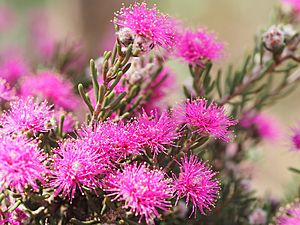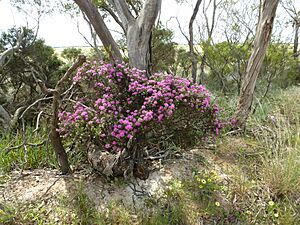Melaleuca plumea facts for kids
Quick facts for kids Melaleuca plumea |
|
|---|---|
 |
|
| M. plumea leaves and flowers | |
| Scientific classification | |
| Genus: |
Melaleuca
|
| Species: |
plumea
|
Melaleuca plumea is a type of shrub that belongs to the myrtle family. It is found only in the southern part of Western Australia. This plant is known for spreading out wide and having many leaves. In spring and early summer, it produces lots of beautiful deep pink flowers. A cool thing about this plant is the fluffy hairs on parts of its flowers, including the small leaf-like parts (called bracts) that cover the flower buds.
Contents
What Melaleuca plumea Looks Like
Melaleuca plumea is a low shrub that grows close to the ground. It can reach a height of 2 m (7 ft) and sometimes spread more than 3 m (10 ft) wide. Its leaves are arranged one after another along the stem. They are about 4.5–10.5 mm (0.2–0.4 in) long and 1.0–2.2 mm (0.04–0.09 in) wide. The leaves are usually long and thin, or narrow and oval-shaped. Their ends can be round or have a short, pointed tip.
The flowers of this plant are pink or purple. They grow in bunches near the ends of the branches. These branches keep growing even after the flowers have bloomed. Flowers also appear where the upper leaves meet the stem. The flower buds are covered by brown, leaf-like structures called bracts. These bracts, along with the base of the flowers (called hypanthia) and the sepals (which protect the flower bud), are all covered with soft, white fluff. Each flower bunch can have up to 5 groups of three flowers. Each bunch is about 17 mm (0.7 in) across. The stamens, which are the parts that give the flowers their bright color, are grouped in 5 bundles around the flower. Each bundle has 5 to 8 stamens. The flowers mostly appear from September to December. After flowering, the plant produces woody fruits called capsules. These capsules are 2.5–3.5 mm (0.1–0.1 in) long and grow in clusters around the stem.

How Melaleuca plumea Got Its Name
The plant Melaleuca plumea was first officially described in 1999. This was done by a scientist named Lyndley Craven when he was reviewing all the plants in the Melaleuca group. The second part of its name, plumea, comes from the Latin word plumeus. This word means "downy" or "fluffy," which describes the woolly, soft parts of its flowers.
Where Melaleuca plumea Grows
This melaleuca plant is found in a specific area of Western Australia. It grows in and around the districts of Salmon Gums, Scaddan, and Mount Beaumont. These areas are part of the Esperance Plains and Mallee regions. You can find it growing in sand or clay soils, on the sides of sand dunes, and near salt lakes and river flats.
Protecting Melaleuca plumea
The Government of Western Australia's Department of Parks and Wildlife has looked at Melaleuca plumea. They have decided that it is "not threatened." This means the plant is not currently in danger of disappearing.
Special Oils in Melaleuca plumea
The leaves of Melaleuca plumea contain special natural oils. These oils are mostly made of substances called monoterpenes. One of the main oils found in its leaves is 1,8-cineole, also known as Eucalyptol.

